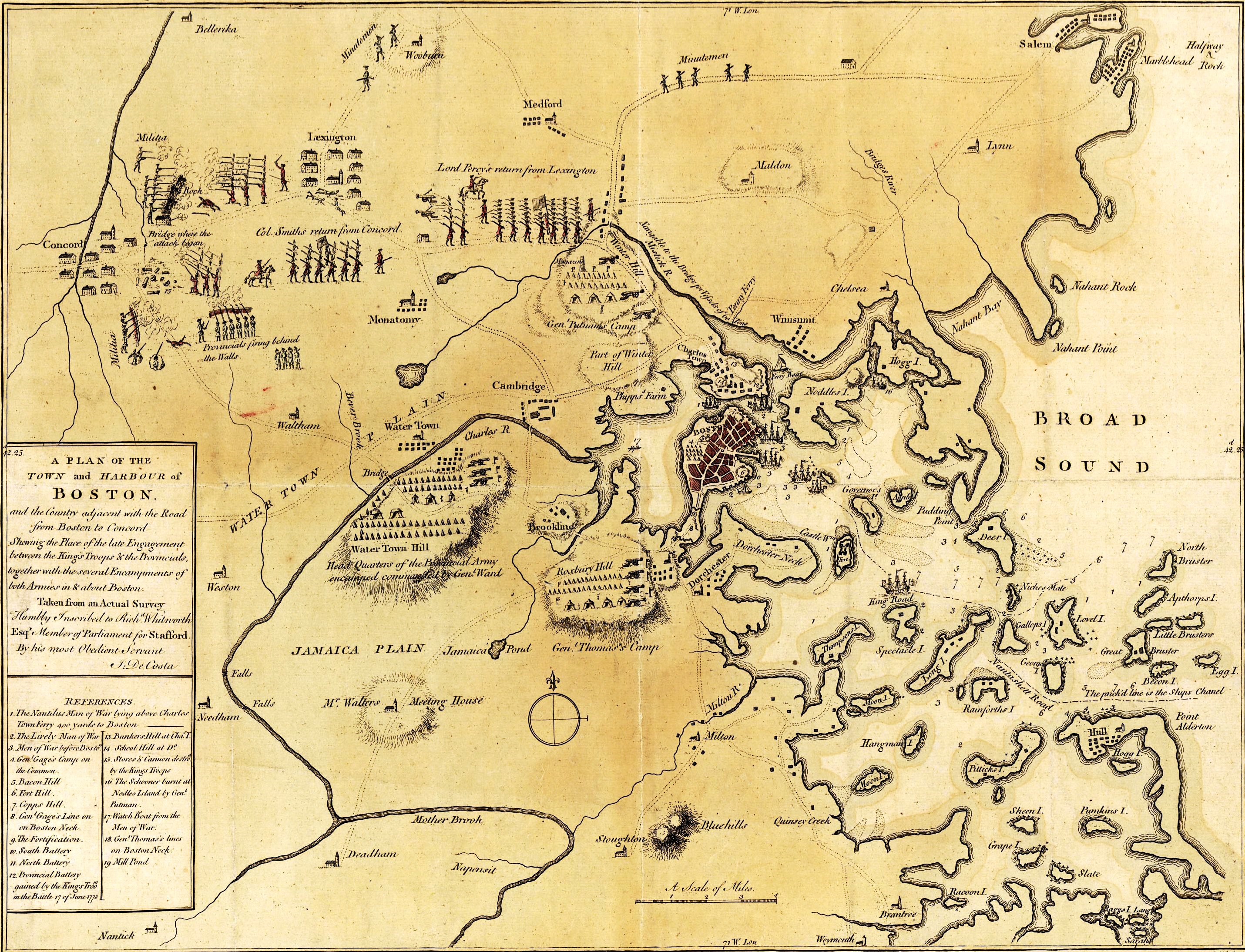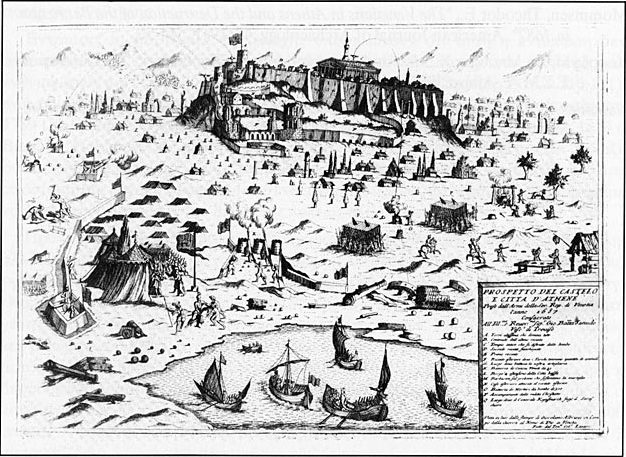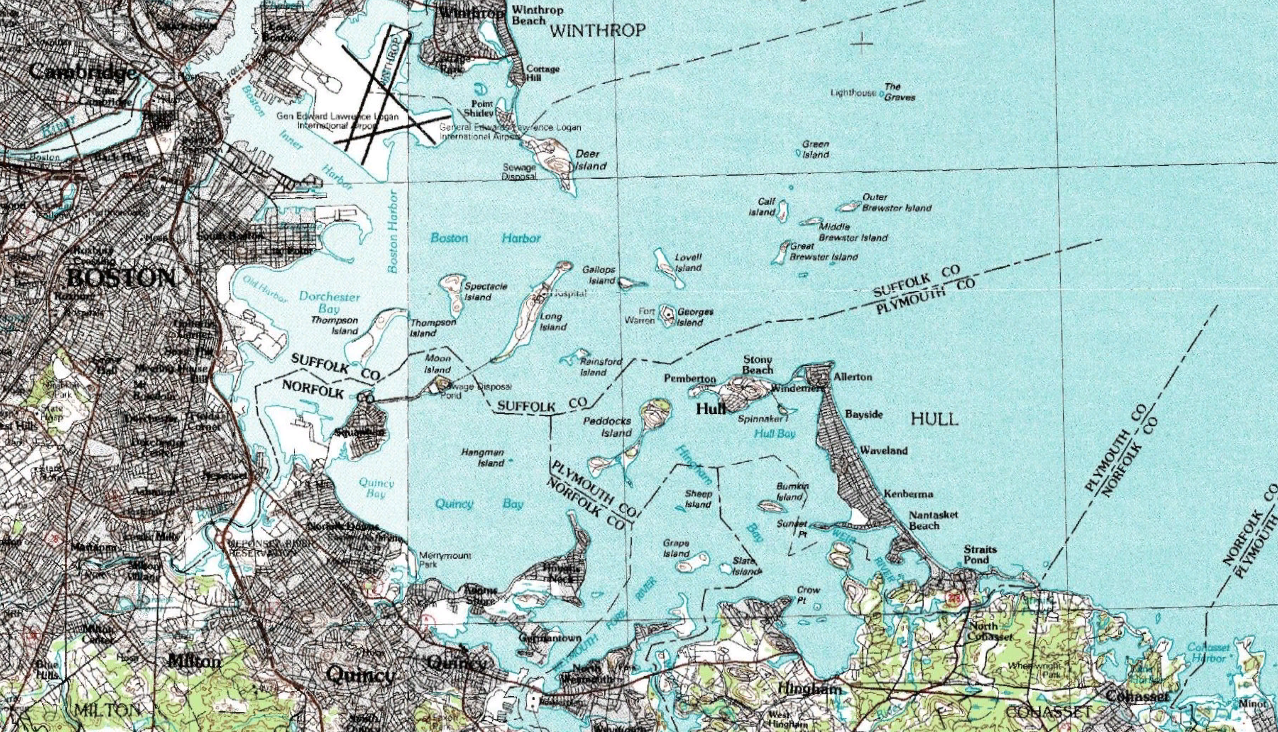|
Burning Of Falmouth
The Burning of Falmouth (October 18, 1775) was an attack by a fleet of Royal Navy vessels on the town of Falmouth, Massachusetts (site of the modern city of Portland, Maine, and not to be confused with the modern towns of Falmouth, Massachusetts, or Falmouth, Maine). The fleet was commanded by Captain Henry Mowat. The attack began with a naval bombardment which included incendiary shot, followed by a landing party meant to complete the town's destruction. The attack was the only major event in what was supposed to be a campaign of retaliation against ports that supported Patriot activities in the early stages of the American Revolutionary War. Among the colonies, news of the attack led to rejection of British authority and the establishment of independent governments. It also led the Second Continental Congress to contest British Naval dominance by forming a Continental Navy. Both Mowat and his superior, Vice-Admiral Samuel Graves, who had ordered Mowat's expedition, suff ... [...More Info...] [...Related Items...] OR: [Wikipedia] [Google] [Baidu] |
American Revolutionary War
The American Revolutionary War (April 19, 1775 – September 3, 1783), also known as the Revolutionary War or American War of Independence, was the armed conflict that comprised the final eight years of the broader American Revolution, in which American Patriot (American Revolution), Patriot forces organized as the Continental Army and commanded by George Washington defeated the British Army during the American Revolutionary War, British Army. The conflict was fought in North America, the Caribbean, and the Atlantic Ocean. The war's outcome seemed uncertain for most of the war. However, Washington and the Continental Army's decisive victory in the Siege of Yorktown in 1781 led King George III and the Kingdom of Great Britain to negotiate an end to the war in the Treaty of Paris (1783), Treaty of Paris two years later, in 1783, in which the British monarchy acknowledged the independence of the Thirteen Colonies, leading to the establishment of the United States as an independent and ... [...More Info...] [...Related Items...] OR: [Wikipedia] [Google] [Baidu] |
Fort Pownall
Fort Pownall was a British fortification built during the French and Indian War, whose remains are located at Fort Point State Park in Stockton Springs, Maine. The fort was named for Governor Thomas Pownall, who oversaw its construction. It never saw action, and was destroyed during the American Revolutionary War by the actions of both colonists and the British military to prevent its further use. The fort's remains were listed on the National Register of Historic Places in 1969. Setting Fort Point State Park is located at the easternmost tip of Cape Jellison, a triangular peninsula which juts into Penobscot Bay at the mouth of the Penobscot River. The park, established in 1974, includes, in addition to the ruins of Fort Pownall, the Fort Point Light. The cape's eastern tip forms a narrow peninsula, with the fort's ruins on the high ground near its easternmost end. History In 1759, during the French and Indian War, Massachusetts governor Thomas Pownall led the construct ... [...More Info...] [...Related Items...] OR: [Wikipedia] [Google] [Baidu] |
Carcass (projectile)
A carcass was an early form of incendiary bomb or shell, intended to set targets on fire. It comprised an external casing, usually of cast iron, filled with a highly flammable mixture, and having three to five holes through which the burning filling could blaze outward."Carcass". ''Oxford English Dictionary''. Oxford University Press. 2nd edition. 1989. Carcasses were shot from howitzers, mortars, and other cannons to set fire to buildings and defences; on impact, the shell shattered, spreading its incendiary filling around the target. Congreve rockets were also sometimes fitted with carcass heads. They were named ''carcass'' because the circles which pass from one ring, or plate, to the other, were thought to resemble the ribs of a human carcass. History Carcasses were used for the first time by the French and Münsterite troops under Louis XIV and Bernard von Galen in 1672. They were also fired from bomb vessels. The carcass shell as used by the Royal Navy in the 18th and e ... [...More Info...] [...Related Items...] OR: [Wikipedia] [Google] [Baidu] |
Magazine (artillery)
A magazine is an item or place within which ammunition or other explosive material is stored. The word is taken originally from the Arabic word ''makhāzin'' (مخازن), meaning "storehouses", via Italian and Middle French. The term is also used for an ammunition dump, a place where large quantities of ammunition are stored for later distribution. This usage is less common. Field magazines In the early history of tube artillery drawn by horses (and later by mechanized vehicles), ammunition was carried in separate unarmored wagons or vehicles. These soft-skinned vehicles were extremely vulnerable to enemy fire and to explosions caused by a weapons malfunction. Therefore, as part of setting up an artillery battery, a designated place would be used to shelter the ready ammunition. In the case of batteries of towed artillery the temporary magazine would be placed, if possible, in a pit, or natural declivity, or surrounded by sandbags or earthworks. Circumstances might requ ... [...More Info...] [...Related Items...] OR: [Wikipedia] [Google] [Baidu] |
Battle Of Bunker Hill
The Battle of Bunker Hill was fought on June 17, 1775, during the Siege of Boston in the first stage of the American Revolutionary War. The battle is named after Bunker Hill in Charlestown, Boston, Charlestown, Massachusetts, which was peripherally involved. It was the original objective of both the colonial and British troops, though the majority of combat took place on the adjacent hill, which became known as Breed's Hill. On June 13, 1775, the leaders of the colonial forces besieging Boston learned that the British were planning to send troops out from the city to fortify the unoccupied hills surrounding the city, which would give them control of Boston Harbor. In response, 1,200 colonial troops under the command of William Prescott stealthily occupied Bunker Hill and Breed's Hill. They constructed a strong redoubt on Breed's Hill overnight, as well as smaller fortified lines across the Charlestown Peninsula. By daybreak of June 17, the British became aware of the presen ... [...More Info...] [...Related Items...] OR: [Wikipedia] [Google] [Baidu] |
Bomb Vessel
A bomb vessel, bomb ship, bomb ketch, or simply bomb was a type of wooden sailing naval ship. Its primary armament was not cannons (Naval long gun, long guns or carronades) – although bomb vessels carried a few cannons for self-defence – but Mortar (weapon), mortars mounted forward near the bow and elevated to a high angle, and projecting their fire in a External ballistics, ballistic arc. Shell (projectile), Explosive shells (also called ''bombs'' at the time) or Carcass (projectile), carcasses were employed rather than solid shot. Bomb vessels were specialized ships designed for bombarding (hence the name) fixed positions on land. In the 20th century, this naval gunfire support role was carried out by the most similar purpose-built World War I- and World War II, II-era Monitor (warship)#Twentieth century, monitors, but also by other warships now firing long-range explosive shells. Development The first recorded deployment of bomb vessels by the English was for the Siege of ... [...More Info...] [...Related Items...] OR: [Wikipedia] [Google] [Baidu] |
Schooner
A schooner ( ) is a type of sailing ship, sailing vessel defined by its Rig (sailing), rig: fore-and-aft rigged on all of two or more Mast (sailing), masts and, in the case of a two-masted schooner, the foremast generally being shorter than the mainmast. A common variant, the topsail schooner also has a square topsail on the foremast, to which may be added a Topgallant sail, topgallant. Differing definitions leave uncertain whether the addition of a Course (sail), fore course would make such a vessel a brigantine. Many schooners are Gaff rig, gaff-rigged, but other examples include Bermuda rig and the staysail schooner. Etymology The term "schooner" first appeared in eastern North America in the early 1700s. The term may be related to a Scots language, Scots word meaning to skip over water, or to skip stones. History The exact origins of schooner rigged vessels are obscure, but by early 17th century they appear in paintings by Dutch marine artists. The earliest known il ... [...More Info...] [...Related Items...] OR: [Wikipedia] [Google] [Baidu] |
HMS Canceaux (1764)
HMS ''Canceaux'' was a sloop active in both the hydrographic exploration of the Atlantic Canada and New England coastline and in the American Revolutionary War. She played an integral role in the battle for control of Maine, in particular at the Burning of Falmouth.Conforti, Joseph ''Creating Portland: History and Place in Northern New England'' (2007) pp. 31&55–58 She began her life as a merchant vessel and would eventually be transformed to a military vessel for the Royal Navy, equipped to command the razing of major settlements. After leaving the Saint Lawrence River estuary in 1771, ''Canceaux'' actively shaped the maritime history of the American Revolution. Incident at Fort William and Mary In December 1774 HMS ''Canceaux'', under the command of Lt. Henry Mowat, attempted to restore order to Fort William and Mary following the seizure of supplies by colonial forces led by Paul Revere. The fort, located on New Castle Island near Portsmouth, New Hampshire, was seen a ... [...More Info...] [...Related Items...] OR: [Wikipedia] [Google] [Baidu] |
Hydrographic Survey
Hydrographic survey is the science of measurement and description of features which affect maritime navigation, marine construction, dredging, offshore wind farms, offshore oil exploration and drilling and related activities. Surveys may also be conducted to determine the route of subsea cables such as telecommunications cables, cables associated with wind farms, and HVDC power cables. Strong emphasis is placed on soundings, shorelines, tides, currents, seabed and submerged obstructions that relate to the previously mentioned activities. The term ''hydrography'' is used synonymously to describe ''maritime cartography'', which in the final stages of the hydrographic process uses the raw data collected through hydrographic survey into information usable by the end user. Hydrography is collected under rules which vary depending on the acceptance authority. Traditionally conducted by ships with a sounding line or echo sounding, surveys are increasingly conducted with the aid o ... [...More Info...] [...Related Items...] OR: [Wikipedia] [Google] [Baidu] |
Mortar (weapon)
A mortar today is usually a simple, lightweight, man-portable, Muzzleloader, muzzle-loaded cannon, consisting of a Smoothbore, smooth-bore (although some models use a Rifling, rifled barrel) metal tube fixed to a base plate (to spread out the recoil) with a lightweight bipod mount and a Sight (device), sight. Mortars are typically used as indirect fire weapons for close fire support with a variety of ammunition. Historically mortars were heavy Siege, siege artillery. Mortars launch explosive shell (projectile), shells (technically called Bomb, bombs) in high arching Projectile motion, ballistic trajectories. History Mortars have been used for hundreds of years. The earliest reported use of mortars was in Korea in a 1413 naval battle when Korean gunsmiths developed the ''wan'gu'' (gourd-shaped mortar) (완구, 碗口). The earliest version of the ''wan'gu'' dates back to 1407. Ch'oe Hae-san (1380–1443), the son of Ch'oe Mu-sŏn (1325–1395), is generally credited with inventi ... [...More Info...] [...Related Items...] OR: [Wikipedia] [Google] [Baidu] |
Swivel Guns
A swivel gun (or simply swivel) is a small cannon mounted on a swiveling stand or fork which allows a very wide arc of movement. Another type of firearm referred to as a swivel gun was an early flintlock combination gun with two barrels that rotated along their axes to allow the shooter to switch between either the rifled or the smoothbore barrels. Swivel guns should not be confused with pivot guns, which were far larger weapons mounted on a horizontal pivot, or screw guns, which are a mountain gun with a segmented barrel. An older term for the type is peterero (alternative spellings include "paterero" and "pederero"). The name was taken from the Spanish name for the gun, pedrero, a combination of the word piedra (stone) and the suffix -ero (-er), because stone was the first type of ammunition fired. It had a high rate of fire, as several chambers could be prepared in advance and quickly fired in succession and was especially effective in anti-personnel roles. It was used ... [...More Info...] [...Related Items...] OR: [Wikipedia] [Google] [Baidu] |
Boston Harbor
Boston Harbor is a natural harbor and estuary of Massachusetts Bay, located adjacent to Boston, Massachusetts. It is home to the Port of Boston, a major shipping facility in the Northeastern United States. History 17th century Since its discovery by Europeans by John Smith in 1614, Boston Harbor has been an important port in American history. Boston Harbor was recognized by Europeans as one of the finest natural harbors in the world due to its depth and natural defense from the Atlantic as a result of the many islands that dot the harbor. It was also favored due to its access to the Charles River, Neponset River, and Mystic River, which made travel from the harbor deeper into Massachusetts far easier. By 1660, almost all imports came to the greater Boston area and the New England coast through the waters of Boston Harbor. A rapid influx of people transformed Boston into an exploding city. 18th century On December 16, 1773, Boston Harbor was the site of the Boston Tea ... [...More Info...] [...Related Items...] OR: [Wikipedia] [Google] [Baidu] |










